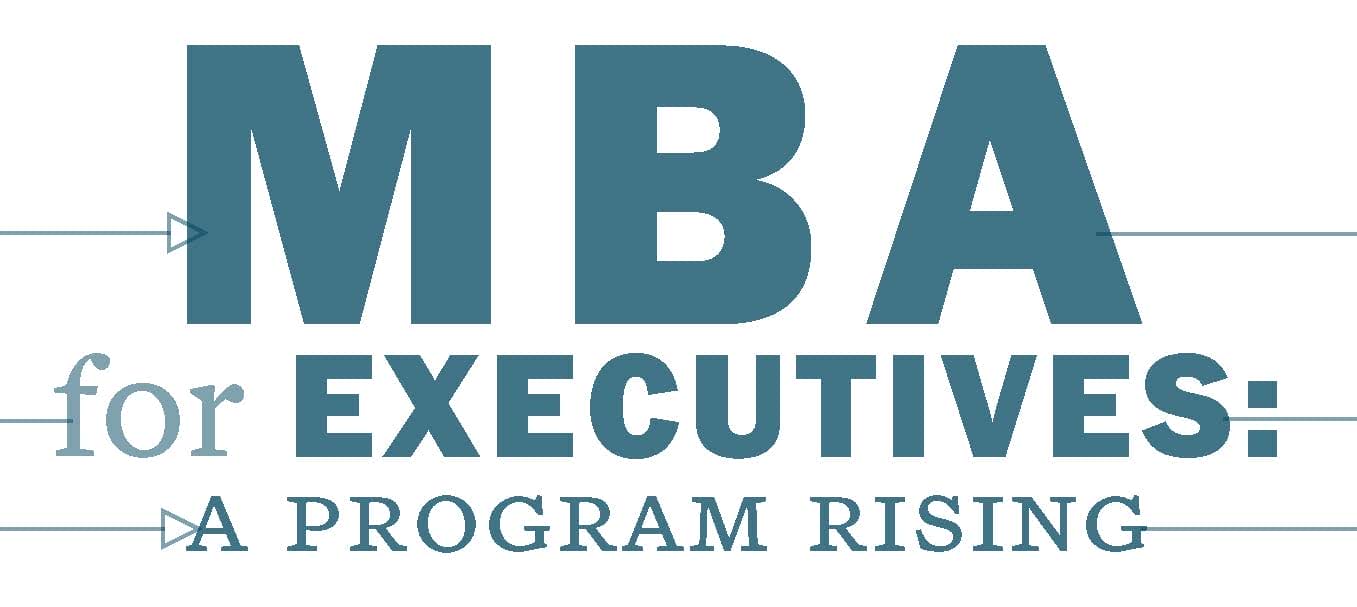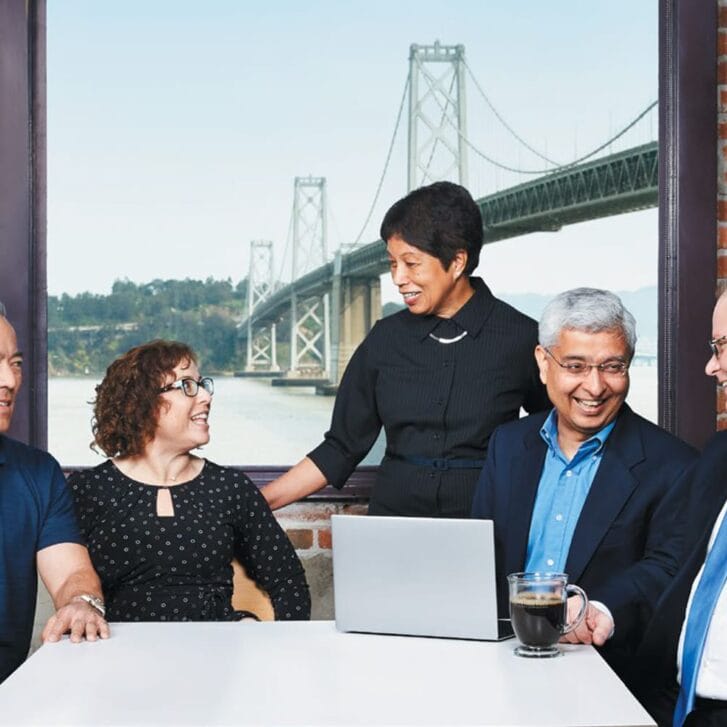Scott Wieler WG87 gave his employer, Bankers Trust, a choice. Either he was going to pursue a fulltime Wharton MBA. Or, he said, “we could do something really interesting and create a new sponsorship program for younger employees to attend Wharton’s WEMBA program.”
He preferred the MBA for Executives Program because he already had his desired job.
“Going back to school [in the mid-1980s] was more about gaining the knowledge and tools that we couldn’t get in our jobs and then being able to test out new concepts in the real-time laboratory of the workforce. You couldn’t do that in a full-time program,” explains Wieler, who since went on to found the Baltimore-based boutique investment advisory firm Signal Hill, where he continues to serve as chairman.
For Wieler to get his wish, not only did his employer have to consent. Wharton had to change its rules.
The School had to amend its requirement that students have at least 10 years of work experience, which it did in 1985 with the creation of the Fellows program. Cathy Molony, who joined the WEMBA staff more than 25 years ago and is now the director of the program in Philadelphia and overall director of WEMBA admissions, calls the establishment of the Fellows category in admissions nothing short of a “turning point.”
“We were getting calls from companies that regularly sponsored students here, but they wanted to sponsor less seasoned employees,” she recalls. “These were high-potential and mature-beyond-their-years employees who the company didn’t want to lose to full-time MBA programs.”
“This became a retention tool for employers as well as a source for recruiting talent,” says Wieler, who maintains his ties with the program and with the School as chair of Wharton’s Graduate Executive Board. “At least three of my Wharton classmates later joined Bankers Trust.”
Wharton’s MBA for Executives Program has experienced quite a few turning points since it was launched in 1975. While many aspects that made the program unique then have stayed the same, the program has evolved in significant ways to always meet the changing demands and expectations of students.
Connect With Us: Walk in the shoes of executive MBA students for a weekend. Watch the video above.
Rise of the Students
Like the expectations of Wieler, who became one of the first WEMBA Fellows. About one in five students in Wieler’s class was a Fellow (out of 76 individuals)—most of them from big banks, telecommunications and pharmaceutical companies, and big six accounting firms, notes Molony.
With Fellows, Wharton could admit less-seasoned students for executive MBAs, while also allowing the School to attract larger classes. Once in the program, one couldn’t tell a Fellow from any other WEMBA student.
As big a turning point as that was for Wieler and the other Fellows, it still was an evolution in a common theme among executive MBA students: They were sponsored. In the 1970s through the early 1990s, most students were sponsored by their companies, which tended to be larger organizations in traditional fields like banking and telecommunications. The MBA for Executives Program admissions team would receive as many as 10 applications from an individual sponsoring company. It was a fairly straightforward model in that selected employees would be tapped to apply to Wharton’s program with expenses paid for by the company.
One of the biggest changes to the executive MBA program since—perhaps a revolutionary turning point in how students view the program—involves the movement away from a sponsorship model toward a self-funded model.
Back in the early ’80s, Fred Wolgel WG85 remembers standing out because he was self-funded. It worked out for him. At the time, Wolgel was a lawyer for the U.S. government in the Federal Energy Regulatory Commission.
“I came to reposition myself and improve my career prospects. I was in a regulatory position and wanted to move into transactional work. WEMBA helped me achieve that goal, as I changed jobs within a year of graduation to move to the private sector,” says Wolgel, who now serves as vice president and general counsel of chemical manufacturer Texas United Corp. in Houston.
These days, self-funding is the path for more students than ever before, and fewer students are sponsored. The numbers bear this out. Peggy Bishop Lane, vice dean of the Wharton MBA for Executives Program, estimates that 20 to 30 years ago, close to four out of five students were financially sponsored under the general notion of staying with that employer throughout their careers. Now, she says, maybe 40 percent of East Coast students are sponsored, and closer to half that percentage are sponsored on the West Coast.
Self-interest is behind this trend for both employers and students, as macro currents in the workplace are driving the trend.
Peter Cappelli, Wharton’s George W. Taylor Professor, who began teaching in the executive MBA program 25 years ago, observes that students are spending—and need to spend—a lot more time managing their careers now.
“Current companies don’t have a coherent plan for them post-MBA. Students know if they want to do anything different with their new skills after graduation, they will probably have to make it happen, so they are trying to learn about opportunities,” says Cappelli, who also directs the School’s Center for Human Resources.
The decision to let someone attend Wharton’s MBA for Executives Program is now likely made by a local manager rather than a corporate headquarters person in charge of talent, Cappelli continues. The local managers “see these programs as being useful for the employee, but not particularly for them, as they don’t necessarily have bigger jobs available in their own unit.” Instead, local managers want the newly minted MBAs to return to their old desks and pay off that local unit’s investment in them.
“The problem is that the employee’s interest in going to WEMBA was virtually always to get out of their current desk,” he says.
“Students still think about what they can do within their company, but they also want to see what else is available,” Lane says.
Now, employers must not only invest the money to sponsor students, they must also actively play a role in managing their career objectives.
“I’m aware of a handful of cases where students reconsidered financial sponsorship because it came with constraints—that is a new trend,” Lane adds.
Rise of the Entrepreneur
Another driver behind the self-funding trend is that more students are entrepreneurial. Sam Kherani, a first-year student who is self-funded and working on a startup, finds entrepreneurship to be enmeshed in the vibrant community at Wharton | San Francisco. In addition to the Silicon Valley ecosystem, he attributes this to entrepreneurs’ need to gain business knowledge and to form trusted networks.
“When you’re considering working with someone, you need a high level of trust, and that doesn’t come from just having dinner a few times. It needs to organically grow from living and studying together, which happens through the residential aspect of the WEMBA program,” the student says.
Originally from Uganda, Kherani is now a 57-year-old practicing dentist in Vancouver with plans to launch a dental continuing education company.
“I came to Wharton to get in-depth training in all areas of business, to broaden my mind and to make the kinds of connections I never could in dentistry,” he explains.
Bernadette Birt, executive director and chief operating officer of Wharton | San Francisco, explains why such “connections”— both intellectually and socially—are possible: “This develops at Wharton because EMBA students share their weaknesses as well as their strengths,” she says. “If they’re not good at something, they are here to fill that gap so they can improve in that area; that openness builds trust.”
The MBA for Executives Program has grown to accommodate the trend of entrepreneurial students, both from the efforts of students and administrators. Take, for instance, the opening of the San Francisco campus, where classes began in 2001. To provide for entrepreneurs and other self-funders, the MBA for Executives Program then hired two full-time career management directors, one for each coast. In Philadelphia, meanwhile, the students of Class 40 formed their own Entrepreneurship Club.
Of course, the WEMBA program has always attracted entrepreneurs. Len Lodish, Wharton’s Samuel R. Harrell Emeritus Professor and inaugural vice dean for Wharton | San Francisco, has taught WEMBA students starting with the first class and recalls advising a student entrepreneur named Herman “Sonny” Waldman WG77, founder of Mainstream Swimsuits.
“We traded ideas during class weekends,” Lodish says.
[well]Rise of Technology
When Fred Wolgel WG85 was an executive MBA student in the 1980s, personal computers were new. Students brought books to class, took notes on paper and, in Wolgel’s case, invested in an IBM desktop. Others used computer terminals in their hotel rooms—without Internet. Fast-forward to Class 40 in 2015, and the technology picture is dramatically different. Students like Riva Dumeny and Sam Kherani bring devices—not books—to classes. The program even provides devices like iPads loaded with course packs. Students take notes on their devices, and can study and connect with one another from anywhere in the world.
For Dumeny’s geographically disparate study group—with members from homes that span several time zones—this is critical. The group relies on Google Hangouts and video chats, along with international texting apps, to communicate when not on campus.
“I suspect that the technology alone has led to an even more international WEMBA program because without that capability, it would have been very difficult to live far from campus,” she says.
The drawback, however, is the never-ending tension between work and school. Students are given the time off by their employers to attend classes every other weekend, yet stay connected with their devices.
“We encourage students to try to unplug from work as much as possible when they are here. This is a gift they are giving themselves, so we want them to focus on being a student during class weekends. Even outside of class, they need to spend time talking to other students to build relationships,” says Bernadette Birt, executive director and chief operating officer of Wharton | San Francisco.
The School also explores technology to connect the two campuses—for instance, the Cisco Connected Classroom.
—Meghan Laska
[/well]
Rise of Global Education
Whatever the changes to the MBA for Executives Program, one aspect is constant: a commitment to diversity, academic rigor and global thinking
Wharton’s MBA for Executives Program was planned by a committee formed in 1973 (chaired by Yoram “Jerry” Wind, Wharton’s Lauder Professor of marketing) when the group was tasked with examining the school’s needs for special degree programs and recommending courses of action. School records indicate that the goal was to attract high-quality participants from the Northeast and across the world without watering down the MBA program. At the end of two years, graduates from the residential WEMBA program would receive the same MBA as their full-time counterparts, stresses Vice Dean of the MBA Program Howard Kaufold W75, who was WEMBA director from 1993 to 2010.
The first class began in June 1975 with 25 students. The School’s annual report from 1974-1975 states that it included two corporate presidents, one college dean, four vice presidents, two bank officers and one governmental agency director, as well as at least a dozen managers. An announcement for that class from 1977 indicates that the average age of students was 37, and they came from Philadelphia; New York City; Boston; Baltimore; Wilmington, Delaware; and Washington, D.C.
Recruitment was working. The second class entered the program in June 1976 with 43 students from as far south as Florida, as far north as Connecticut and as far west as Ohio. Students ranged in age from 28 to 54 years old and included six women.
During the 1980s, as in the 1970s, the majority of students came from the Boston-to-D.C. corridor, but in the 1990s, a larger proportion of students began commuting from places farther afield. When Wharton | San Francisco opened in 2001, it became more feasible to commute from anywhere in the world to a Wharton campus.
Kaufold says the majority of current students have international work experience, and many are from other countries. In the current first-year Philadelphia class, 38 percent of the 119 students are international. In the West Coast class of 107 first-year students, about half are international. San Francisco first-years are commuting from such locales as South Korea, Hong Kong, Peru and Canada, while the half who are domestic travelers come from around the country.
International diversity and perspective are crucial to recruit today’s students.
“An MBA is required for my professional goals, but I had spent my career with one company, so I also wanted to gain perspective on other industries and geographies. Wharton provides that diversity as well as challenging academics,” says Riva Dumeny, a first-year WEMBA student on the Philadelphia campus.
She points to her study group as an example of student diversity. Dumeny is executive vice president at NEBCO and vice president at AmWINS Group, both insurance firms. She lives in Orlando, Florida, with her family, but commutes to Rhode Island each week for her job. Another student was born in Ireland but lives in Miami, serving as CEO of a technical products firm. A third member was born in Poland and now works in banking in Switzerland. Rounding out the study group is a student from Argentina who lives in Florida and works in banking, a student commuting from Mexico who works in real estate, and a
U.S.-born student working as a chief accounting officer at a bank in Miami.
Lane hopes to only advance this trend. The School administration focuses on how to create an ever-greater global experience for its students.
“We admit students from all over the world, our faculty [members] have global backgrounds, and we offer global experiences. We want to consider: How can we expand that further?” she says.
Rise of the Future Program?
That leads the reader to ask: What’s next? What will be the next crucial turning point for Wharton’s MBA for Executives Program?
Forecasting 40 years into the future is a challenge in any sector, even one as steeped in tradition as higher education. But as the Wharton MBA for Executives Program continues to respond to the changing needs and realities of the business world and students themselves, rest assured that certain trends probably will continue—one notably being the quality of students. Wharton attracts elite individuals for all the reasons mentioned above, and others you would expect, but executive MBA students are special by their very nature.
“Students apply what they’re learning immediately to their jobs. That’s exciting for students and faculty, and that level of excitement is contagious,” Lane says.
Long-time teacher Lodish puts it this way: “Having more work experience, they are more likely to have made a big mistake in their career and are very willing to listen and learn. And when they come to class, they share how what they learned in the prior weekend session worked or didn’t work. I often adapted our class discussions as a result. That is a very attractive environment for professors and why faculty love teaching WEMBA classes.”
—Meghan Laska is a freelance writer and editor based near Boston. A former communications staff member at Wharton, she has also previously worked as a legal journalist.
Connect With Us: Read more of Leonard Lodish’s reflections on 40 Years in Wharton’s MBA for Executives Program on the WEMBA Blog at: http://whr.tn/wemba-blog.


























